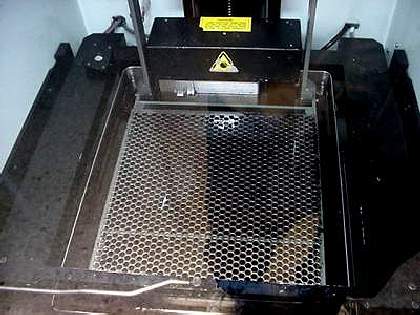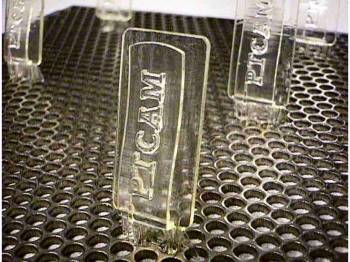Stereolithography
How are parts built?
SLA enables the building of complex, 3-D models by successively "laser-forming" cross sections of liquid resin, using data from most surface or solid modeling CAD systems.The .STL file sent to the machine is sliced into small layers and the laser is driven by the design.

The liquid plastic hardens only where touched by the laser beam, and the model is built layer-by-layer, without tooling, programming, or machining. Where the polymer is sufficiently exposed to the laser's beam, it hardens down to a regulated depth.
After each pass of the laser, the platform on which the exposed polymer sits is lowered, submerging the hardened material under the surface of the liquid in the vat. Another pass of the laser then hardens the next layer of polymer. When the platform moves down, it moves the elevator lower by 0.002 to 0.015 inches depending on the desired accuracy. The additional layer fuse to the already solidified ones.
When the part is finished the uncured resin is drained off and the supports are removed. After the supports are removed the part is cleaned and then smoothed.

The SLA machine

The platform holds the part and
is lowered to create new layers.

Multiple parts made using SLA.

The oven used to cure the finished part.
If you would like to get a part manufactured using SLA, contact Jim DiPasquale (jimdipas@engrng.pitt.edu) from University of Pittsburgh. You will need to send him an .STL file and the dimensions of your part.
If you would like to watch a video of the process, go to the following link:
http://www.rapidsolutions.com/pages/stereolithographybottom2.htm
How is Design Information Transmitted to the Manufacturing Process?
You must send the part to the SLA machine in .STL format. If you are using IronCAD, follow these directions:
1. Part Properties > Rendering
2. Set Facet Surface Smoothing to 150
3. File > Export
4. Choose .STL
Most machines accept either .stl or .iges files.
What Materials does the Process Use?
SLA machines are able to use photopolymers, which are plastics that react to lasers. One downside to SLA is that these materials are fairly brittle.
What are the Size and Shape Limitations?
The maximum size for large format SLA machines is 20in x 20in x 23 in.
The thinnest possible layer is between 0.002 and 0.015 inches. The minimum laser diameter is 0.0029 inches.
How much do parts cost?
The SLA machine equipment can cost between $100,000 and $400,000.
The cost of the parts to be manufactured depends on the size, number of parts, turnaround time, material required, and the finishing specifications. Companies have done stereolithogrpahy for around $30/hour. A simple small finished prototype part typically starts at approximately $100. When we received an estimate for the propeller, it was $425.
How Quickly Can Parts Be Made?
The SLA machine creates parts in about 0.001" to 0.006" layers. The time to do the entire part depends on how much surface area has to be hardened. Most parts are ready to be cured within a couple of hours.
For example, a part the size and complexity of a cellular phone would take about six hours on an SLA machine.
Useful Links
www.stereolithography.com
www.rapidsolutions.com
www.howstuffworks.com/stereolith.htm
Randi Dembski
Sara Stille
Alyssa Zeller





